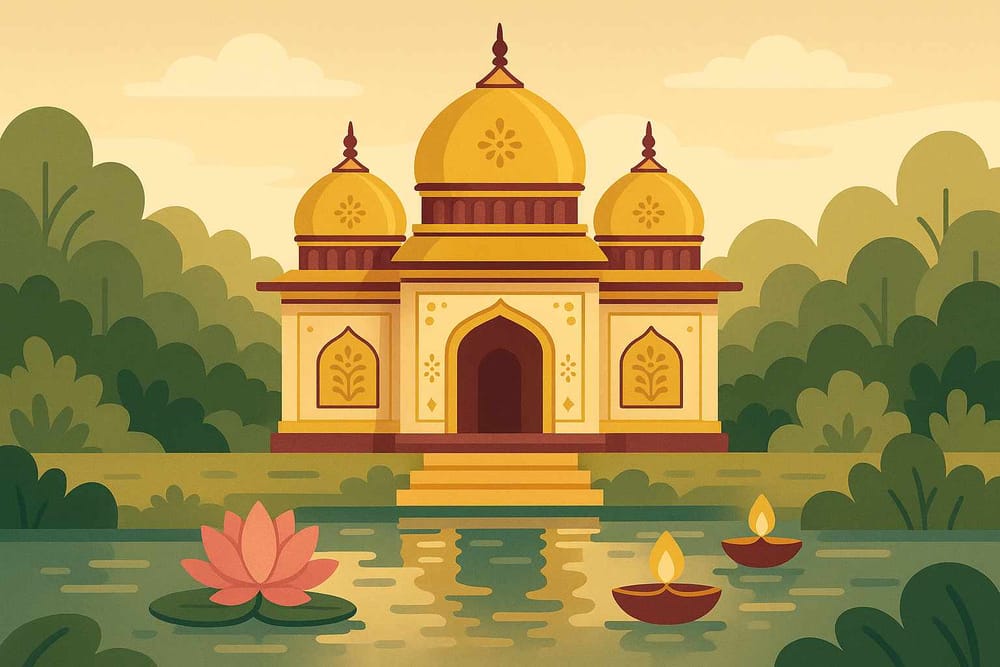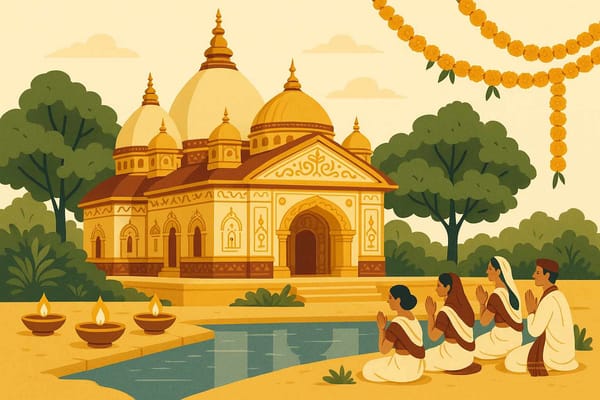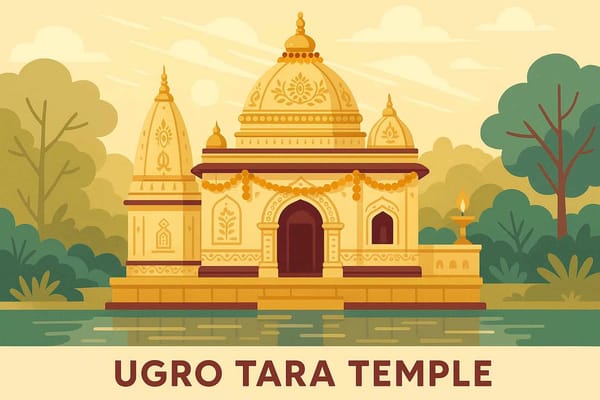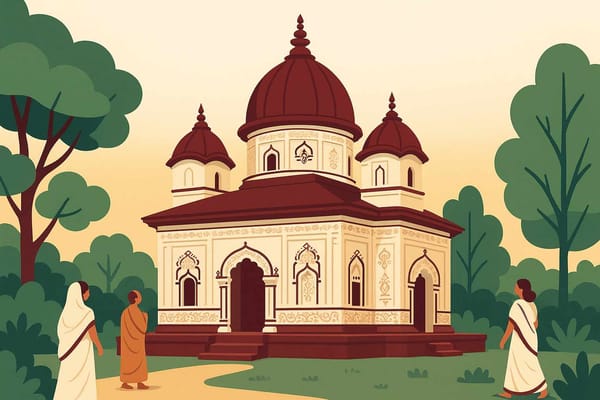
Exploring the Mystical Ugro Tara Temple: Spirituality and Culture Await
There are some places of worship that you visit, and then there are some that visit you, leaving a mark on your soul long after you’ve left. In the bustling Uzan Bazar of Guwahati, tucked away from the city's hum, lies such a sanctuary – the Ugro Tara Temple. When I first heard about it, I pictured a grand idol, a fierce goddess carved in stone. But what I found was something far more profound, something that speaks to the very essence of faith.
Here, you won't find a traditional murti. Instead, your gaze is drawn to a simple pit of water, a sanctified space that is worshipped as the living, breathing presence of the Goddess. This is the heart of the Ugro Tara Temple, a powerful reminder that the divine is formless, all-pervading, and as elemental as water itself. It's a place that challenges your expectations and invites you to connect with Shakti in her most primal form.
A Divine Presence in a Sacred Pool
The name 'Ugro Tara' itself evokes a powerful image. 'Ugra' means fierce, and Tara, a form of Goddess Parvati, is known for her protective and compassionate nature. Here, she is revered in her fiery aspect, the one who fiercely protects her devotees from all evil. Devotees believe this spot is an ancient Shakti Peetha, a place where the navel of Devi Sati is said to have fallen, infusing the very earth with divine energy.
The worship here is as unique as the sanctum. Goddess Ugra Tara, in her demonic form, is believed to appreciate offerings that reflect her untamed nature, such as liquor, alongside the more traditional red hibiscus flowers, coconuts, and mustard oil. This practice, rooted in Tantric traditions, speaks of a faith that embraces all aspects of the divine – the fierce and the gentle, the creator and the destroyer. It’s a space where people come seeking protection, strength to overcome life's battles, and the courage to face their fears.
Echoes of Royalty: The History Etched in Time
The temple's story is deeply intertwined with Assam's rich past. It was the Ahom King, Siva Singha, who built this temple in 1725, creating a focal point for Shakti worship. His devotion didn't stop there. To the east of the temple, he excavated two large tanks, the Jorepukhuri, or twin ponds, which still add to the serene atmosphere of the area today. These ponds are not just water bodies; they are a legacy of a king's faith.
The temple has stood the test of time, even surviving a devastating earthquake in 1897. Its architecture, with the classic sloping roof characteristic of the Ahom style, tells a story of resilience and unwavering devotion. Walking through its premises feels like stepping into a living history book, where every stone has a story to tell about Assam's spiritual heritage.
Experiencing the Temple's Vibrant Spirit
A visit to the Ugro Tara Temple is an experience for all senses. The air is thick with the fragrance of incense and oil lamps, mingling with the soft chants of the priests. Daily rituals like Archana and Arathi fill the space with a palpable spiritual energy. One of the most beautiful traditions is the distribution of 'Khichdi Prasad,' a simple, blessed meal that unites everyone, breaking down all barriers.
Many who come here wonder if they, as non-Assamese visitors, can partake in the rituals. The answer is a resounding yes. The temple's doors are open to everyone, welcoming all who come with a sincere heart. You can light a diya, offer flowers, or simply sit in quiet contemplation, absorbing the peace of the surroundings. The temple truly comes alive during festivals like Navaratri, when the celebrations are a beautiful display of traditional music, dance, and unwavering faith, making it one of the best times to visit for a truly immersive experience.
For those embarking on a spiritual journey, this temple is an unmissable destination. Much like exploring Udaipur's deep cultural and spiritual practices, a visit here offers a profound glimpse into a region's unique soul. The temple is easily accessible, located right in the heart of Guwahati, making it a peaceful stop for both pilgrims and curious travellers.
A Symbol of Enduring Faith and Culture
The Ugro Tara Temple is more than just a building; it is a lifeline to the traditions and culture of Assam. It’s a place where faith is not just seen but felt, where the divine isn't confined to an idol but flows freely. A visit here is a journey inward, a chance to connect with a powerful stream of devotion that has been flowing for centuries.
It reminds us that spirituality can be found in the simplest of things – a pool of water, a heartfelt prayer, a shared meal. It is this simple, profound truth that you carry with you when you leave.
Why Bhaktilipi? Your Path to Bhakti & Beyond
At Bhaktilipi, we believe in making these profound spiritual traditions accessible. We are your trusted space for exploring the richness of devotional literature, understanding sacred rituals, and connecting with stories like that of the Ugro Tara Temple. We simplify ancient knowledge for today’s world, helping you weave tradition into your modern life.
Discover and Connect with Bhaktilipi
Deepen your understanding of India's incredible spiritual heritage with us. Through our platform, you can gain authentic insights that bring you closer to these sacred traditions. We strive to be the bridge that connects you to the heart of bhakti.
Stay connected with Bhaktilipi for more such enlightening content. Follow us on Facebook, Instagram, and subscribe to our YouTube channel for regular updates and inspiration.
A passionate group of people dedicated to preserving India's knowledge of Dharma, Karma, and Bhakti for ourselves and the world 🙏.
Comments
Related in

Ugro Tara Temple Mystique: Explores Cultural Significance
In the middle of Guwahati's busy streets, where life moves at a whirlwind pace, there is a place of profound stillness and immense power. It's a place where you can feel the energy in the very air you breathe. I'm talking about the Ugratara

Explore Ugro Tara Temple- Culture and History Journey
In the bustling heart of Guwahati's Uzan Bazar, amidst the familiar sounds of city life, there lies a place of profound stillness and immense power. It's the Ugro Tara Temple, or Ugratara Devalaya as it is fondly known. This isn't just another temple; it’

Ugro Tara Temple- History- Architecture- Significance: Explore Now
In the heart of bustling Guwahati, where the mighty Brahmaputra flows with ancient secrets, lies a place of quiet, immense power – the Ugro Tara Temple. It’s not a place of towering gopurams or grand halls. Instead, its magic lies in its simplicity, its deep-rooted history, and the palpable presence
